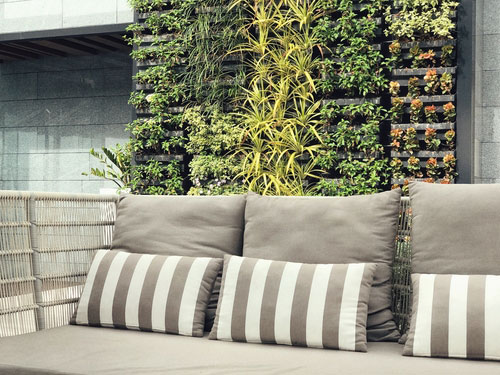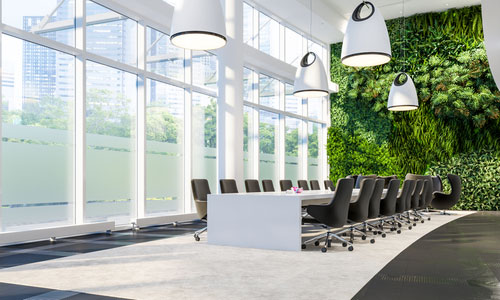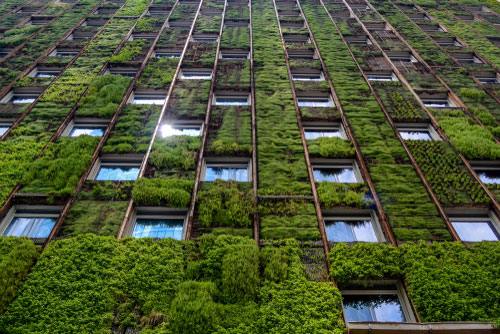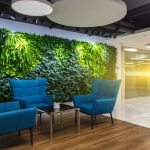Do you want to further develop the CSR strategy of your company? What if installing green walls helped you improve the environmental impact of urban areas and local biodiversity, while improving employee productivity and well-being and reducing energy costs? In this piece, we take a closer look at how companies can adopt green walls as a CSR solution that’s able to positively benefit both business and the surrounding community and ecosystems.
Why Bring Green Walls To Urban Areas?
Green walls are vertical structures, indoor or out, usually comprised of plants and other vegetation, growing media, irrigation and drainage. Green walls can be used for different purposes in a set of different environments, from aesthetic purposes to creating a more natural atmosphere or a place to foster innovative ideas.
Green walls work very well at minimizing the effects of urban infrastructure while improving social and economic value, a paper from Urrestarazu defends. That’s why urban greening initiatives such as green walls are a good way of achieving cities’ ecological goals while reducing the negative side effects of urbanization. This becomes particularly relevant under a scenario where it is expected that +70% of the world’s population will be living in urban areas by 2050. As Manso and Castro-Point point out, the use of outer surfaces of buildings, either walls or roofs, shows up as a very interesting alternative to adopt in usual dense urban areas lacking green spaces and street-level areas and having a hard fight fighting air pollution problems.
So what if businesses wanting to improve their corporate responsibility strategy bet on installing green walls? Both inside vertical green walls or outside vertical walls have the potential to bring social, environmental, and even financial benefits for companies. Let’s take a closer look.
Benefit 1 Of Vertical Green Walls: Purified Air
Studies done on this topic show that living green walls filter particulate matter in the air. This includes chemical toxins such as benzene, formaldehyde or carbon monoxide and carbon dioxide, this latter one converted into oxygen. More specifically, thanks to the leaves, stems and roots of plants, and also to the microorganisms living in the roots and soil, 1 m2 of living wall can extract 2.3 kg of CO2 per annum from the air and produce 1.7 kg of oxygen. In this way, they work as natural air-filters that help create a cleaner and healthier working environment, ultimately improving the workplace air and workers’ health.
Benefit 2 Of Vertical Green Walls: Increased Well-Being
As green offers the feels of relaxation and stress reduction, working in a green environment has a positive effect on well-being. Furthermore, as a consequence of cleaner air, headaches, respiratory problems, complaints such as sore throats or irritated eyes are also less likely to happen.
Benefit 3 Of Vertical Green Walls: Increased Productivity And Innovation

Green walls can also facilitate a more positive mood and more efficient decision-making and innovative ideas. In fact, studies say green workplaces can result in a 15% increase in productivity. Furthermore, a paper from Samaranayake and De Silva also shows that in a factory environment, 86% of employees perceive that their performance improved after working in a greener place.
Benefit 4 Of Vertical Green Walls: Noise Level Reduction
Vertical green walls and dense green facades (walls with climbing plants) also act as noise barriers. They can absorb noise up to 8 dB (depending on the plant species), allowing a quieter environment. And if we consider green facades, they’re said to absorb 41% more sound than a traditional facade. Even in long roads and highways, vegetation has been used as a natural way of reducing noise caused by traffic.
Benefits 5 & 6 Of Vertical Green Walls: Ambient Temperature Regulation And Energy Cost Reduction
Looking at buildings from the inside, plants are a better way to absorb heat than the standard building materials like cement, wood, metals, among others. Thanks to a process of evapotranspiration, they have a cooling effect that keeps temperatures lower. Furthermore, outside plant layers also work as a thermal insulation, which means they help to keep both the heat and the cool outside when temperatures are either warm or cold. And they also reflect sun rays, avoiding more heat from coming inside buildings. Overall, they reduce the need for using air conditioning, which translates into energy and money savings (and less GHG too).
Benefit 7 Of Vertical Green Walls: It Improves Brand Reputation
All the benefits referred above contribute to an increase in the building’s value. Not only financially speaking (as walls get better protected and energy costs are lower), but also in a perspective where buildings can be perceived and showcase the environmental and social concerns of a business. In this way, businesses betting on green walls have a chance to positively influence the perception stakeholders such as job candidates, clients, partners, investors or the media have about their sustainability concerns.
Benefit 8 Of Vertical Green Walls: Showcasing Partnerships For Sustainable Development

As cities consume over two-thirds of the world’s energy and account for more than 70% of global CO2 emissions, many of the world’s busiest cities are trying to get carbon neutral by 2050. In national and local plans some cities are already starting to adopt new measures where citizens are encouraged (and probably later, forced) to adopt new, more ecological behaviors. As green areas help tackle this problem by absorbing CO2, synergies between businesses aligned with the public sector would be very important for the planet and would simultaneously help grow business reputations.
Benefit 9 Of Vertical Green Walls: Improving Biodiversity

In a few words, biodiversity can be understood as the range of different kinds of living forms within an ecosystem. Plants from vertical green walls promote biodiversity in an urban environment made of concrete and asphalt as they enrich the lives of birds, insects and other species of plants. Sure, perhaps some wildlife insects could be annoying, but through a careful design and choice of plants, specific species can either be attracted or repelled, according to Papadopoulou’s paper.
- Related:
Great! But Mind That Green Walls Can Have Downsides Too
All the benefits mentioned above are for sure great incentives for companies (and public or third section institutions) to bet on installing green walls. However, it’s also important to note they might come along with some downsides too.
For instance, a study from Neapolis University In Cyprus highlights that when buildings have already started deteriorating, plants can fast forward this process. Also, the materials used for building up green walls are often synthetic (oil-based) polluting materials those extraction, production, and transportation is polluting. And people with allergic reactions to green walls on indoor spaces might not like very much the idea either.
However, all the previous cons can be solved when things are well thought and planned. In fact, the authors offer solutions to stop or minimize these problems, showing that the benefits clearly outstep the cons. So what do you say? Are you up to finding someone specialized in green walls to help you transition to a greener business?
Images credits to area on Shutterstock, garden on Shutterstock, wall on Shutterstock and building on Shutterstock

